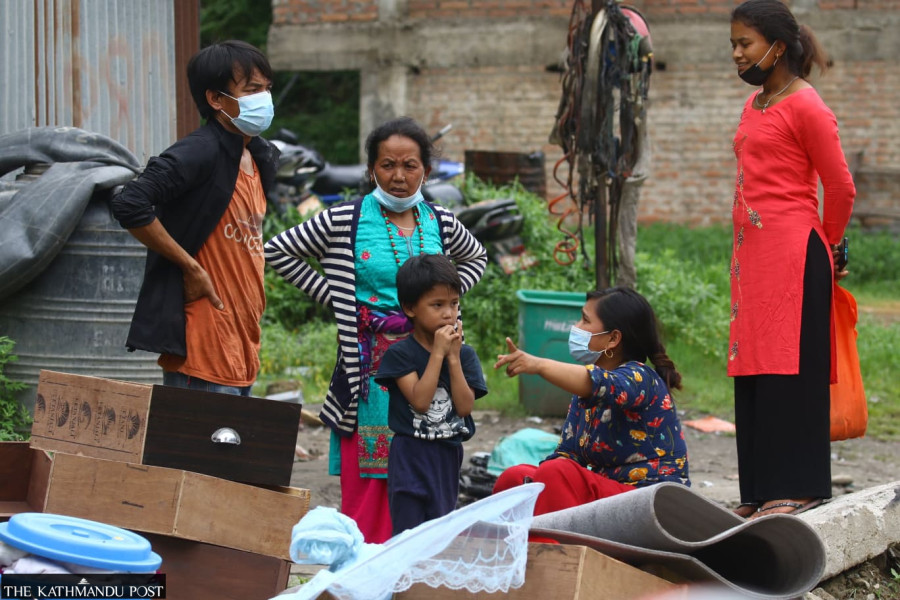Climate & Environment
No lesson learned from the last year’s monsoon devastations
Displaced people are at risk of many communicable and vector borne diseases in the monsoon season.
Arjun Poudel
On June 15 last year, when heavy rains caused the Melamchi river of Sindhupalchok district to swell, houses were swept away. Suprabha Giri from Helambu Rural Municipality actively participated in relief and rescue operations.
Another disaster struck on July 31, one far more devastating than the previous, and led to the displacement of Giri and her family.
“Entire settlements of our area were swept away by the floods,” Giri told the Post over phone from Helambu. “We became homeless within a minute. We had a three-story concrete house but now have been forced to take refuge at other people’s homes.”
When the Melamchi river destroyed main structures—headwork, tunnel and roads—of Melamchi Water Supply Project, the Marshyangdi river swept Manang’s steel bridge and persistent rainfall caused severe damage to Mechi Highway, exposing both the magnitude of the devastations monsoon can bring upon and the lack of preparedness.
This was highlighted in a government report prepared after the disaster.
“No one imagined the disaster of Melamchi, Manang and Panchthar districts. The loss incurred by the country in a short period after the start of monsoon indicates the risk continues,” states the report prepared by the National Disaster Risk Reduction and Management Authority under the ministry of Home Affairs. “We got a chance to identify our weakness from last year’s disaster and we also learned a lesson that we should change our preparedness plan.”
But the plight of the people displaced by last year’s Melamchi floods shows that no lesson has been learned.
At least 308 families were displaced by the floods and landslides in Helambu Rural Municipality alone.
Giri, who is also an employee at Helambu Rural Municipality, said that her family has got nothing from any agency.
“We are even deprived of the Rs 20,000 relief, which the government provided to the families of the displaced after the disaster,” she said. “Hundreds of families who were displaced by the disaster have been living pathetic lives.”
Officials at the Helambu Rural Municipality admit that people displaced from the disasters have been deprived of the relief.
“We have recommended Rs500,000 each to the displaced families as a support to build homes and for other immediate reliefs,” said Nirajan Mainali, a disaster focal person at the rural municipality. “We have also asked the federal government agencies to map the places where displaced people have been residing but no action has been taken yet.”
Displaced people have been compelled to live in makeshift shelters set up after the disasters, some constructed near the damaged houses, which are in risky zones, according to Giri.
Now that the pre-monsoon is already active, with rains lashing the country, the displaced are worried.
Meteorologists have forecast above-normal monsoon rains this year.
The displaced people living in makeshift shelters are also at the risk of many communicable and vector-borne diseases during the monsoon season.
Nepal is highly vulnerable to natural disasters—earthquakes, landslides and flooding, among others. The country, however, is not capable of handling large-scale disasters, experts say. They say that the reactive approach of the authorities concerned is responsible for loss of lives and properties in the disasters.
“We tend to wait until disasters strike,” said Shakti Gurung, executive director at the Center for Disaster Management Studies. “After casualties and loss of properties, our agencies spring into action. And then after a few months, everyone forgets. Such a reactive approach will not help us mitigate the risks and loss from the possible disasters.”
According to Gurung, there’s a need to have a proactive approach and make monsoon preparedness plans effective by taking initiatives to save lives and properties.
Officials at the National Disaster Risk Reduction and Management Authority said that local level government agencies are responsible to handle the disaster preparedness.
“We have made policies and guidelines and are ready to assist local governments if they need help,” said Dijan Bhattarai, spokesperson for the authority. “But local units are the first responders.”
Most of the agencies under local units, however, are ill-equipped and lack the expertise to handle disaster-related incidents.
Experts say the government’s responsibility is more than just formulating policies and guidelines.
“It is not because we lack policies or guidelines that work is not being done. We do have policies in place,” said Gurung, of the Center for Disaster Management Studies. “What we lack is sincere implementation.”




 11.12°C Kathmandu
11.12°C Kathmandu








%20(1).jpg&w=300&height=200)

